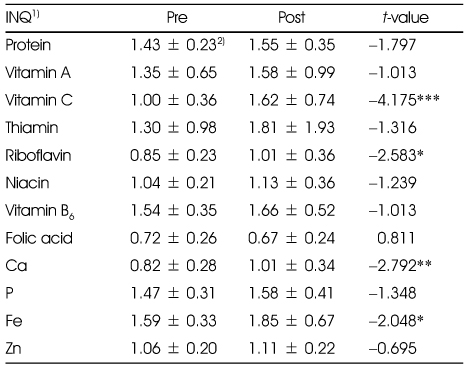References
1. Ahn HJ, Koo BK, Jung JY, Kwon HR, Kim HJ, Park KS, Han KA, Min KW. Bowl-based meal plan versus food exchange-based meal plan for dietary intake control in Korean type 2 diabetic patients. Korean Diabetes J 2009. 33155–163.
2. Choe JS, Baeg HY. Seasonal variation of nutritional intake and quality in adults in longevity areas. J Korean Soc Food Sci Nutr 2004. 33(4)668–678.
3. Choi Y, Kim C, Park YS. The effect of nutritional education program in physical health, nutritional status and health-related quality of life of the elderly in Seoul. Korean J Nutr 2007. 40(3)270–280.
4. Do HJ, Lee YM. A study on customized nutrition intervention program design and application for the low-income elderly. Korean J Community Nutr 2011. 15(6)716–729.
5. Eom HS, Jeong MJ, Kim SB. A study on nutrition knowledge, dietary attitude, food habit of middle school students in Chonbuk area. Korean J Community Nutr 2005. 10(5)574–581.
6. Ha AH, Ryu HS. Patterns of food habits and food intake by age: base on the nutrition counseling data of medical health examination. Korean J Food Nutr 2010. 23(4)531–541.
7. Han KH, Choi MS, Park JS. Nutritional risk and its related factors evaluated by the mini nutritional assessment for the elderly who are meal service participants. Korean J Nutr 2004. 37(8)675–687.
8. Kang HJ, Shin EM, Kim KW. Evaluation of nutrition education for diabetes mellitus management of older adults. Korean J Community Nutr 2009. 14(6)734–745.
9. Kang Y, Kim M, Lee E. The relationship of perceived health status, activities of daily living and nutrition status in the community-dwelling Korea elderly. J Korean Acad Nurs 2008. 38(1)122–130.
10. Kim OS, Ryu HS. The study on blood lipid levels according to the food habits and food intake patterns in Korean elderly. Korean J Food Nutr 2009. 3421–429.
11. Kim SB, Choi HJ. Effects of nutrition education using food exchange system: changes in elementary students' nutrition knowledge, dietary attitude and nutrients intake. Korean J Community Nutr 2008. 13(6)922–933.
12. Kim TY, Suh MO. The effect of nutrition education on weight control in male workers by the community health center. J Korean Diet Assoc 2008. 14(4)351–360.
13. Korea Health Industry Development Institute, KHIDI. Korea health industry statistics system 2009. cited 2012 January 10. Available from
http://www.khidi.or.kr.
15. Korean National Statistical Office. The statistics of mortality and the causes 2010. cited 2011 December 26. Available from
http://www.kostat.go.kr.
16. Korean Nutrition Society. Dietary Reference Intakes 2010. Seoul: Han-A Reum publishing; 579–583.
17. Lee DH. The effects of quality of life in the elderly's health condition. J Korean Gerontol Soc 2010. 30(1)93–108.
18. Lee SL, Kim YL, Lee SJ, Cho YK, Choi YK. Effects of diabetes education on diabetic management in non insulin-dependent diabetics mellitus patients. J Korean Diet Assoc 2004. 10(3)300–308.
19. Kim MJ, Kwon S, Ly SY. Effects of low glycemic index nutrition education on the blood glucose control in patients with type 2 diabetes mellitus. Korean J Nutr 2010. 43(1)46–56.
20. Lee YA, Kim KN, Chang NS. The effect of nutrition education on weight control and diet quality in middle-aged women. Korean J Nutr 2008. 41(1)54–64.
21. Nam HM, Woo SH, Cho YJ, Choi YJ, Back SY, Yoon SY, Lee JY, Lee JJ, Lee HJ. Effects of nutritional education practice program for cardiocerebrovascular high-risk group at the education information center. Korean J Community Nutr 2011. 16(5)580–591.
22. Oh JY, Kim SB. Development and effects analysis of nutrition education program for diabetes mellitus at community health center-focus on individual daily energy requirements and food exchange units. Korean J Community Nutr 2010. 15(4)485–497.
23. Shim JE, Paik HY, Moon HK. Breakfast consumption pattern, diet quality and health outcomes in adults from 2001 national health and nutrition survey. Korean J Nutr 2007. 40(5)451–462.
24. Shin JW, Park YK, Seo SR, Kim JE. Factors influencing quality of life in elderly diabetic patients of Korea: Analysis from the Korea national health and nutrition examination survey in 2008. J Korean Gerontol Soc 2011. 31(3)479–487.
25. Son SM, Im HS, Kim JH, Lee JH, Seo JS, Son JM. Clinical Nutrition 2008. 4thth ed. Paju: Kyomunsa; 147–149.
186–189.
230–231.
261–262.
26. Yang EJ, Bang HM. Nutritional status and health risks of low income elderly women in Gwangju area. Korean J Nutr 2008. 41(1)65–76.
27. Yang IS, Jung HY, Lee HY, Chae IS. Analyzing the current practice of the home-delivered meal(HDM) service program for homebound elderly. Korean J Community Nutr 2003a. 8(5)736–743.
28. Yang JL, Seo HJ, Kim YH. Effects of nutrition education on nutritional status of hemodialysis patients. Korean J Nutr 2003b. 36(7)749–758.
29. Yim KS. The effects of a nutrition education program for hypertensive female elderly at the public health center. Korean J Community Nutr 2008. 13(5)640–652.
30. Yim KS, Lee TY. Sociodemographic factors associated with nutrients intakes of elderly in Korea. Korean J Nutr 2004. 37(3)210–222.








